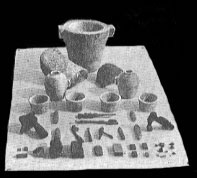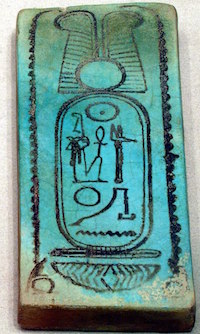In modern times, it is fairly common for a dignitary or well-known personality to symbolically initiate the construction of a new building with a “ground-breaking” ceremony. The ancient Egyptian equivalent was the “foundation rituals” which conferred the protection of the gods on the building works and the finished building.
The practice of burying “foundation deposits” was standard in the construction of temples, palaces, tombs, and forts. Deposits were placed at the corners of buildings or at points of importance in the structure. The location of the deposits was dependent on the type of structure. Temples would have a deposit at each corner, while tombs would have deposits by their entrances. Deposits were also placed under obelisks, columns, hypostyle halls, sanctuaries and along the central axes of the buildings.
The earliest ancient Egyptian foundation deposits date from the Early Period and the latest, to the Christian period. During the Old Kingdom, deposit pits tended to be small and generally included food offerings, ceramics and grindstones.
By the Middle Kingdom, the pits were larger and also included inscribed model tools and bricks with inscribed items within them. They reached the height of their popularity during the New Kingdom and votive plaques were added to the contents. During the latter part of the New Kingdom (the Ramesside period) items were often mass produced and included more extensive inscriptions and a wider variety of amulets and objects.
The practice then seems to have become less popular and widespread. A number of deposits of bronze faience and copper plaques and model pottery were discovered in Tanis dating to the Third Intermediate Period and a few similar objects dating to the Late Period have also been recovered. There was an increased interest again during the Ptolemaic Period (when the rituals for building temples also became more complex) but while there are a number of Egyptians style deposits (which are similar to those from the late period) most deposits have a clearly Greek influence and bilingual inscriptions.


The foundation rituals for temples actually consisted of eight separate rituals (or eleven during the Ptolemaic Period) of which the burying of foundation deposits was only one. The rituals were supposed to be conducted by the Pharaoh, but in reality they were generally conducted on his behalf, with the pharaoh taking on this role on a few of the more important structures.
Foundation rituals stages
- Pharaoh leaves his palace with his royal standard bearers and travels to the site of the temple (Ptolemaic Period)
- Pharaoh arrives at the construction site and is greeted by the priest representing the god to whom the temple will be dedicated (Ptolemaic Period)
- “Stretching the Cord”- (“pedj shes”)
- Hoeing the earth and digging the first foundation trench (“ba ta”)
- Moulding the first bricks
- Pouring the sand
- Burying foundation deposits
- Beginning construction
- Purifying the completed building
- Dedicating the temple to the gods
- Pharaoh leaves the palace to visit the completed building (Ptolemaic Period).
Stretching the Cord
“Stretching the cord” (“pedj-shes”) was one of the most important elements of the whole foundation ritual. Its importance was such that in later times the entire ritual up to the point of construction was known as “pedj-shes”. From as early as the Second dynasty, the ceremony was closely associated with the goddess Seshat, “Mistress of the House of Architects”. The “cord” in question is the mason’s line which was used to measure out the dimensions of the building and align the building with the stars or points of the compass.
This stage ritual had three distinct phases;
- Marking out the four corners of the building (at night using the stars).
- “Stretching the cord” (driving stakes into the four corners and tying the cord to link them).
- Loosening the cord (so that it slipped down the stakes and lay on the ground marking the limits of the building).

It is often noted that the Ancient Egyptians were incredibly accurate in the laying of foundations and the orientation of their buildings. It is thought that they used a tool known as a “merket”, a notched stick though which the constellation of the Great Bear could be viewed to enable the builders to calculate the position of true north and align their buildings accurately.
“I hold the peg. I grasp the handle of the club and grip the measuring cord with Seshat. I turn my eyes to the movements of the stars. I send forth my gaze to the Bull’s thigh (the Great Bear). I count off time, I watch the clock, I establish the four corners of your temple”
Words spoken by the Pharaoh, from an inscription at Edfu temple.Hoeing the Earth
Hoeing the ground (“ba ta”) bears the most marked resemblance to modern ceremonies. In this ritual the pharaoh (or priest representing him) was considered to be the heir of the Earth god (Geb). He would start the first foundation trench of the temple with a wooden hoe, and so was thought to symbolically cut through the earth to the water table which represented the upper limit of Nun, the primeval water god.
Moulding the first Brick
The pharaoh (or priest representing him) would use a wooden mould to make a mud brick to represent the bricks which were originally used for all buildings (before they had mastered stone masonry). These single mud bricks were often inscribed with the name of the king who dedicated the building and then buried in one of the foundation deposits.
Pouring the Sand
The pharaoh would pour a thin layer of sand from the banks of the Nile into the foundation trenches. The workmen would then take over and fill in the trenches with Nile sand to create a smooth level base for construction.
Burying foundation deposits
Foundation deposits were buried at key places around the site. The deposits were generally placed in pits lined with mud-brick which varied greatly in size. They were generally circular or semicircular, but occasionally square or rectangular. The contents also varied considerably but often included: models of building equipment and offerings, bricks or the moulds for bricks, votive plaques (generally made of faience, limestone, or wood) ceramic saucers and bowls, and occasionally the head of a goose and a bull.
The objects were generally symbolic and made of cheap materials but occasionally jewellery would also be buried in the pit (e.g. A few Carnelian beads were found in the foundation deposits of Hatshepsut’s temple at Deir el Bahri). No objects of any real value have been found buried with foundation deposits.
The Archaeologist Petrie described a foundation deposit he excavated at Kahun,
“In the middle of the temple area a hole thirty-one inches square was excavated in the rock about four feet deep, to contain the foundation deposits. Into this the four sets of objects were thrown, without any arrangement or order. Each set of models consisted of a small chisel, long chisel, wide chisel, long knife , large pointed knife, small pointed knife, and hatchet, all of bronze ; a pair of corn rubbers of brown sandstone; and two strings of carnelian beads, averaging about a foot in length. Two or three pieces of green carbonate of copper ore, and a piece of galena were also thrown in. Over these a quantity of pottery vessels and some baskets, and straw or fibre, accompanied the deposit.
Deposits were rarely inscribed outside of the Middle Kingdom and the New Kingdom and even then inscriptions tended to be fairly brief; often noting only the name of the pharaoh, the building and the names of gods to which it was dedicated. Execration texts were also buried in foundation deposits (largely during the Twelfth Dynasty) and from the New Kingdom (and particularly during the Late Period) a selection of the materials used during construction were buried with the foundation deposits.
Beginning construction
The pharaoh would place a large stone block at one corner of the temple using a large wooden lever to manipulate the block. This was intended to initiate the construction of the temple. As the building and decorating of a temple took a significant amount of time and a great deal of organisation, there was often quite a gap between the completion of this ritual and the next ritual to dedicate the completed building.
Purifying the completed building
Once the construction was completed, the building had to be purified before it could be dedicated. The ritual was known as “Strewing of the Besen”, with Besen translated as either gypsum (calcium sulfate dihydrate also known as Plaster of Paris) or natron (a mixture of naturally occurring salts). It is generally agreed that natron is more likely because of its association with purification and use in mummification.
Dedicating temple
The final ritual was the dedication of the completed temple to the god for whom it was built. The pharaoh stood before a Naos shrine in which an image of the god sat and made offerings and said prayers to dedicate the temple. The ceremony was known as the “Opening of the Mouth of the Throne-of-the-Protector-of-my-Father” (echoing the ritual which was a major part of the mummification rituals). This ritual allowed the god to inhabit their statue (which was not yet divine as it had been created by a human). Animals were then sacrificed and offerings presented to the god. Finally, the ceremony was repeated for the entire building (officially making it the home of the god).
Bibliography
- Bard, Kathryn (2008) An introduction to the Archaeology of Ancient Egypt
- Redford Donald B (2002) Ancient Gods Speak
Copyright J Hill 2010